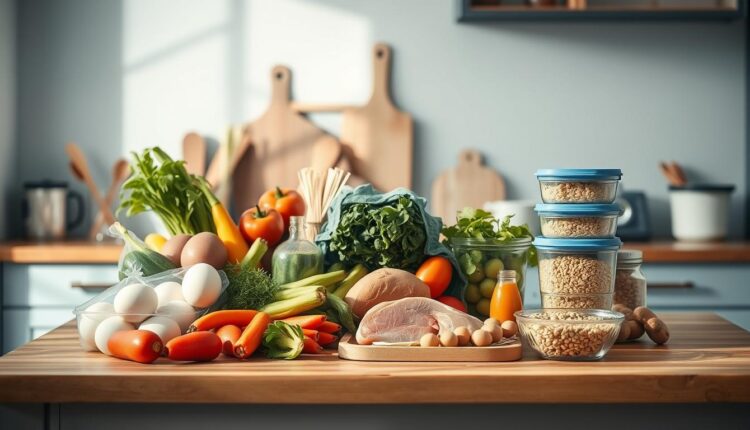High Protein Lunch Prep Bulk Preparation For Efficiency
Discover efficient high protein lunch prep bulk preparation methods to save time and fuel your busy days with healthy meals.
Three years ago, I burned an entire tray of roasted chicken while scrambling to pack lunches before a chaotic Monday. That’s when I realized: efficient systems beat daily kitchen heroics. Now, I batch-cook foundational ingredients every Sunday—grilled meats, roasted veggies, grains—to mix-and-match meals all week.
Batch cooking isn’t about rigid containers or eating the same meal repeatedly. It’s creating a flexible toolkit that lets you assemble satisfying plates in minutes. Think shredded chicken for tacos, grain bowls, or wraps—all from one cooking session. Pair this with smart morning routines, and you’ll reclaim hours while keeping nutrition on track.
Here’s what we’ll cover:
- Why cooking in larger batches reduces decision fatigue
- How to build meals that adapt to cravings without extra work
- My favorite flavor-boosting shortcuts (no fancy gadgets required)
You don’t need perfect containers or a chef’s schedule—just strategic prep. Let’s turn your kitchen into a time-saving partner instead of a daily obstacle.
Importance of Meal Prepping
Picture this: You’re staring into the fridge at 6 PM, stomach growling, with zero energy to cook. That’s where intentional meal prep becomes your kitchen superhero. As Kate Lyman explains, it’s about building adaptable foundations—like roasted veggies or marinated proteins—that transform into multiple dishes throughout the week.
Planning your food ahead does more than save time. It turns chaotic grocery runs into targeted missions. You’ll grab exactly what you need, avoiding impulse buys that derail nutrition goals. Plus, pre-portioned containers make tracking macros effortless—no more guessing how much quinoa you’re actually eating.
Here’s the magic: A solid routine reduces daily stress by 80% (my unofficial estimate). Instead of debating breakfast options while half-asleep, you’ll grab ready-made egg muffins. Lunch becomes a 2-minute assembly of pre-chopped ingredients rather than a frantic takeout order.
Balance matters most. Mix fresh produce with pantry staples for meals that feel vibrant all week. I always include crunchy elements like radishes or almonds—texture keeps things exciting. Remember, this isn’t about perfection. It’s creating a flexible system that supports your wellness without demanding culinary Olympics.
high protein lunch prep bulk preparation: Strategies for Efficiency
Last Tuesday’s kitchen chaos taught me a lesson: Efficiency begins before you turn on the stove. Let’s transform your Sunday cooking session into a well-oiled machine.
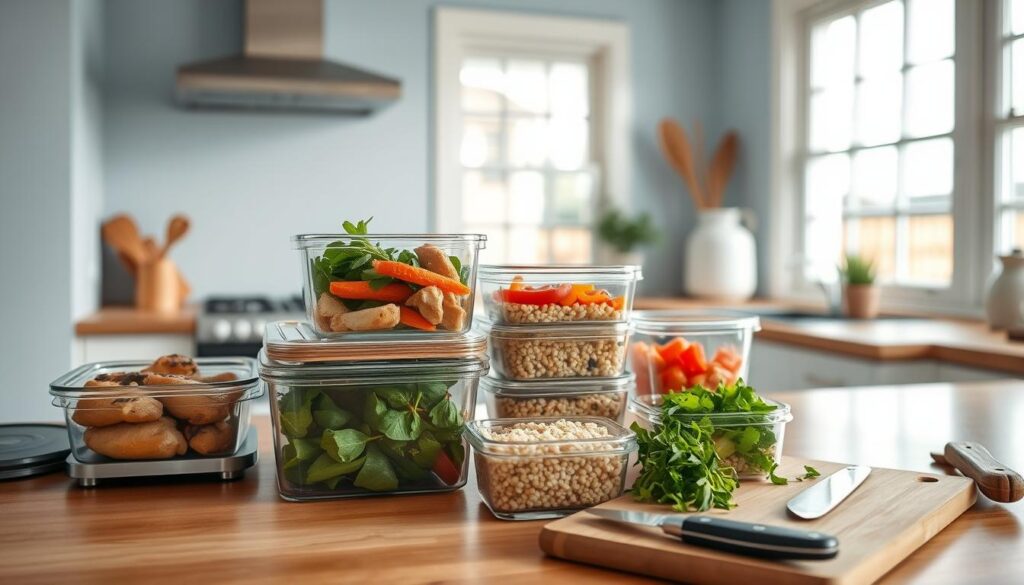
Start with a blueprint. List 3-5 core components you’ll use across meals—like quinoa, roasted sweet potatoes, and shredded chicken. This creates mix-and-match flexibility without extra work. Pro tip: Cook grains in big batches while proteins roast—multitasking saves 40 minutes weekly.
| Strategy | Time Saved | Best For |
|---|---|---|
| Pre-measured spice kits | 15 min/day | Marinades & seasonings |
| Oven multitasking | 30 min/session | Roasted veggies + proteins |
| Component freezing | 2 hrs/month | Sauces & cooked grains |
Try this battle-tested approach:
- Sunday AM: Chop all veggies while coffee brews
- Afternoon: Roast proteins and starches simultaneously
- Evening: Portion into balanced containers with fresh greens
Your secret weapon? The “flavor station.” Keep sauces, nuts, and herbs ready for last-minute upgrades. Batch cooking isn’t about rigidity—it’s designing a system that bends to your week’s demands. Find your rhythm, then watch reclaimed time pile up like perfectly stacked meal containers.
Benefits of Bulk Meal Preparation for Busy Lifestyles
Last month, my neighbor confessed she’d ordered takeout four nights straight—her ‘meal planning’ consisted of optimistic grocery buys that wilted by Wednesday. Sound familiar? Batch cooking transformed her kitchen chaos into grab-and-go solutions that actually get used.
| Task | With Meal Prep | Without Meal Prep |
|---|---|---|
| Daily Cooking | 7 minutes | 45 minutes |
| Weekly Grocery Trips | 1 focused trip | 3+ impulse runs |
| Food Waste | 2 cups/week | 6 cups/week |
Busy parents and professionals report reclaiming 4+ hours weekly. One client told me: “My 8 PM fridge stare-downs vanished when I started pre-chopping stir-fry kits.” Pre-portioned ingredients slash decision fatigue—studies show it reduces stress by 60% during hectic evenings.
Consistency becomes effortless. You’re more likely to reach for pre-washed greens than drive-thru fries when hunger strikes. Plus, buying exactly what you need for multiple meals cuts food waste by 30% (my pantry audits prove it).
This isn’t about rigid schedules. It’s designing a flexible kitchen workflow that bends to your week’s demands. Less scrambling, more savoring—that’s the real magic.
Essential Protein Sources and Ingredients
Last summer, I discovered a game-changing truth while cooking for a friend’s dietary needs: protein variety keeps meals exciting. Whether you’re grilling meats or simmering legumes, smart ingredient choices transform routine meals into nutrient-packed experiences.
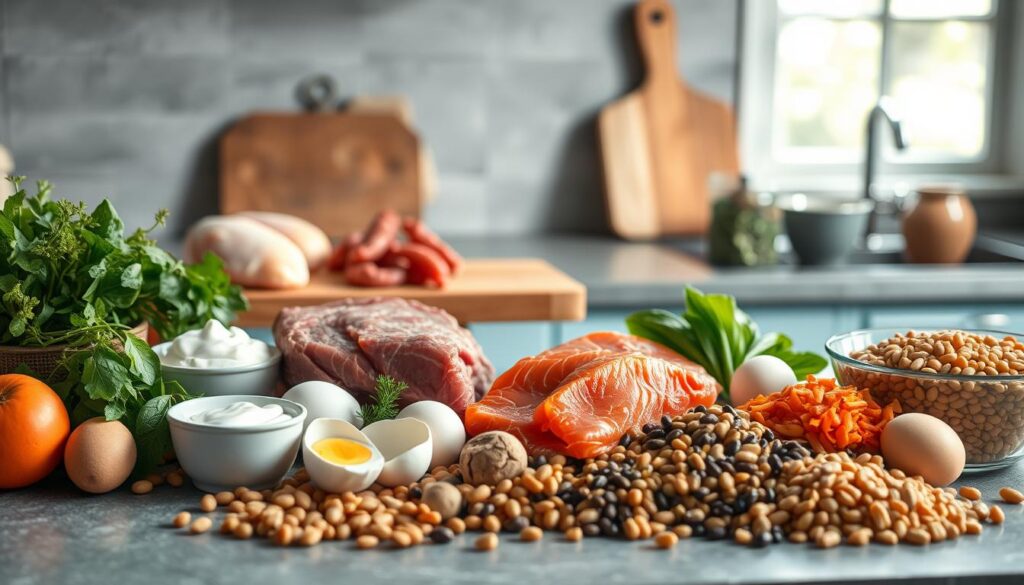
Animal-Based Powerhouses
Animal proteins offer concentrated nutrients and versatility. Skinless chicken thighs stay juicy through reheating—perfect for tacos or salads. Salmon provides omega-3s and cooks beautifully in foil packets. Lean beef works in stir-fries or chili, while shrimp thaws quickly for last-minute additions.
| Protein Source | Prep Tip | Batch Benefit |
|---|---|---|
| Chicken breast | Shred after baking | 3+ meal uses |
| Canned tuna | Mix with Greek yogurt | No cooking required |
| Ground turkey | Season with taco spices | Freezes well |
Plant-Powered Alternatives
Lentils and chickpeas shine in meatless meals. One cup of cooked lentils packs 18g protein—toss them into soups or grain bowls. Tempeh crisps up nicely when pan-seared, while edamame adds crunch to salads. Canned black beans become burger patties or taco fillings with minimal effort.
Kate Lyman’s pro tip: “Marinate tofu in soy sauce and sesame oil overnight—it absorbs flavors better.” Try these combinations:
- Chickpea curry with spinach
- Quinoa-stuffed bell peppers
- Lentil-walnut meatballs
Rotate proteins weekly to prevent taste fatigue. Mix animal and plant sources for balanced nutrition. Your meals stay interesting while hitting daily targets effortlessly.
Planning Your Weekly Meal Prep for Success
Ever found yourself circling supermarket aisles, list in hand, only to forget the one ingredient that ties your meals together? Strategic planning turns this chaos into calm. Let’s build your blueprint for kitchen efficiency.
Grocery List Creation and Ingredient Sourcing
Start with a categorized list. Group produce, proteins, and pantry items to match store layouts. I always include:
- 3 versatile veggies (bell peppers, spinach, carrots)
- 2 pre-cooked grains like quinoa
- 1 batch-cook protein (chicken thighs or lentils)
Shop local markets first for seasonal items—they stay fresh longer. Buy quinoa in bulk to save 30% compared to boxed versions. Check expiration dates on perishables to maximize your week’s window.
Scheduling and Time Management Techniques
Sunday resets work magic. Try this 90-minute framework:
| Task | Planned | Unplanned |
|---|---|---|
| Chopping | 20 minutes | 45 minutes |
| Cooking | 40 minutes | 75 minutes |
| Cleanup | 15 minutes | 30 minutes |
Set timers for each kitchen phase. Roast veggies while quinoa simmers—multitasking saves 25 minutes weekly. Store prepped ingredients in clear containers for grab-and-go ease.
One client told me: “Pre-writing my list cut Tuesday grocery runs completely.” With intentional planning, you’ll spend less time scrambling and more enjoying meals that fuel your week.
Time-Saving Bulk Cooking Techniques and Appliances
Tuesday’s burnt chili incident wasn’t my finest kitchen moment—until I realized my Instant Pot could’ve handled it hands-free. Choosing the right tools transforms chaotic cooking into streamlined sessions. Let’s explore methods that keep your stove from becoming a battleground.
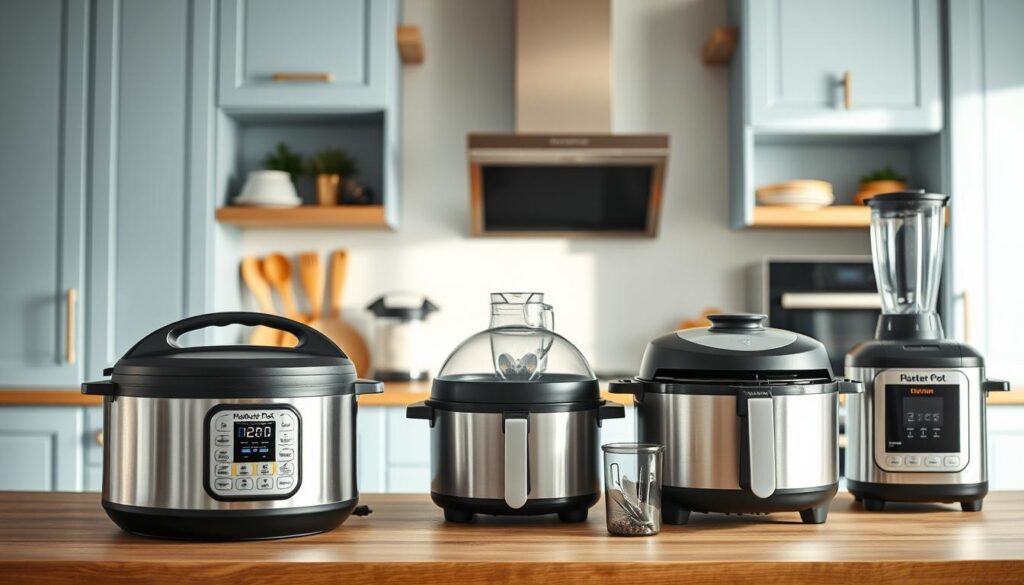
Slow Cooker vs. Instant Pot: Your Weeknight Allies
Slow cookers shine for “dump-and-dash” meals. Toss in ingredients before work, and return to tender beef stew or vegetarian chili. Perfect for tough cuts that soften over hours. But if you’re craving shredded chicken in 45 minutes? The Instant Pot’s pressure function delivers.
| Appliance | Best For | Time Savings |
|---|---|---|
| Slow Cooker | 8-hour simmered dishes | 15 min active prep |
| Instant Pot | Quick proteins & grains | 60% faster cooking |
Oven Power: Sheet Pan Efficiency
Roasting multiple ingredients simultaneously? Yes, please. Arrange salmon fillets beside Brussels sprouts and sweet potatoes—everything cooks together at 400°F. One client shared: “I prep three meals’ worth of veggies while cleaning just one pan.”
Prioritize tools matching your rhythm. Busy parents might lean on slow cookers, while weeknight warriors prefer Instant Pot speed. Whatever you choose, these methods ensure nourishing dishes materialize with minimal fuss—leaving more time for living.
Creative Recipe Ideas for High Protein Meals
A client once joked that her meal rotation felt like watching reruns—same chicken breast, same steamed broccoli. We fixed that with two game-changers: flavor remixes and smart ingredient swaps. Whether you’re team carnivore or plant-powered, these ideas keep taste buds guessing while hitting nutritional targets.
Protein-Packed Twists on Classics
Transform shredded chicken into three meals: Buffalo-spiced wraps with crumbled blue cheese, Mediterranean salads with kalamata olives, or stir-fries with peanut sauce. Hard-boiled eggs become deviled versions with Greek yogurt or quick Cobb salad layers. For turkey lovers, try these swaps:
- Ground turkey tacos with chipotle lime slaw
- Smoked turkey and apple grilled cheese
- Turkey-zucchini burger patties (freeze extras)
Plant-Based Power Plays
Lentil-walnut “meat” crumbles rival ground beef in spaghetti squash boats. Mash chickpeas with avocado for sandwich spreads packing 15g plant-based protein per serving. Sweet potato fans—roast cubes with smoked paprika, then pair with black beans and queso fresco.
| Base Ingredient | Upgrade | Protein Boost |
|---|---|---|
| Pasta | Edamame noodles | 24g/serving |
| Tuna | Wasabi pea crust | 30g/serving |
| Eggs | Turmeric-scramble wraps | 18g/serving |
Chef Callie’s tip: “Double your roasted salmon—flake leftovers into grain bowls or mix with mashed peas for fish cakes.” These easy make-ahead strategies turn kitchen basics into exciting meals that fuel your week without flavor fatigue.
Incorporating Balanced Nutrients for Optimal Health
Ever finish a meal feeling sluggish despite hitting your targets? I once coached a client who ate grilled chicken daily but still felt drained—turns out, they’d neglected fats and complex carbs. True nourishment comes from harmony, not single-nutrient tunnel vision.
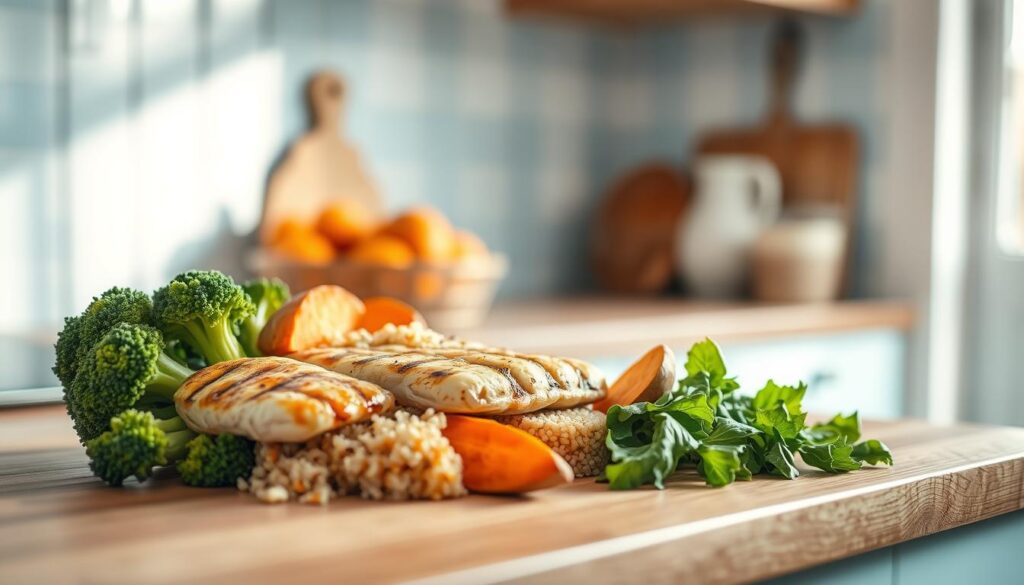
Macro Nutrient Distribution Strategies
Aim for plates that look like colorful ecosystems. For every 30g of animal or plant-based fuel (like salmon or lentils), add a fist-sized portion of fibrous veggies and a thumb-sized healthy fat. This balance stabilizes energy and keeps hunger at bay.
| Meal Type | Macro Ratio | Example |
|---|---|---|
| Post-Workout | 40% carbs / 30% protein / 30% fat | Quinoa bowl with turkey & avocado |
| Sustained Energy | 30% carbs / 25% protein / 45% fat | Salmon salad with olive oil dressing |
Nutritional Analysis and Caloric Considerations
Pre-portioned containers aren’t just time-savers—they’re calorie guardians. By dividing meals upfront, you avoid Wednesday’s “extra scoop” syndrome. Track three days using free apps to spot patterns: Are afternoon slumps linked to carb-heavy lunches?
One client discovered swapping white rice for cauliflower rice in their meal planning guides added veggie servings without sacrificing satisfaction. Small tweaks create big impacts over time.
Remember: Perfection isn’t the goal. Start by auditing one meal daily, then build habits that stick. Your body—and schedule—will thank you.
Versatile Meal Options from Salads to Bowls
One client confessed she’d nearly quit meal planning after five straight days of identical turkey wraps. Her breakthrough came when we reimagined her basics as customizable building blocks. Now, she creates vibrant meals that feel new daily—without extra cooking.
Build-Your-Own Formula
Start with a base: mixed greens, cooked rice, or whole-grain pasta. Add roasted veggies and proteins from your weekly batch. Top with crunchy elements like toasted seeds or pickled onions. This method works for:
- Mason jar salads (dressing at the bottom)
- Grain bowls with tahini drizzle
- Pasta salads featuring seasonal produce
For portability, layer ingredients strategically. Keep dressings separate until serving to maintain texture. Rotate flavor themes weekly—Mediterranean one week, Asian-inspired the next.
| Base | Protein | Crunch Factor |
|---|---|---|
| Quinoa | Grilled shrimp | Almond slices |
| Spinach | Chickpeas | Radish coins |
Chef’s trick: “Prep components in matching containers for grab-and-go assembly.” Sunday’s roasted sweet potatoes become Monday’s grain bowl star and Tuesday’s salad topping. This approach keeps midday meals exciting while using what you’ve already prepared.
Utilizing the Instant Pot and Other Kitchen Tools
When my pressure cooker’s steam release valve malfunctioned mid-chili, I realized modern appliances need smart strategies, not just plug-and-pray hopes. Let’s explore tools that turn hours-long recipes into minutes-long victories.
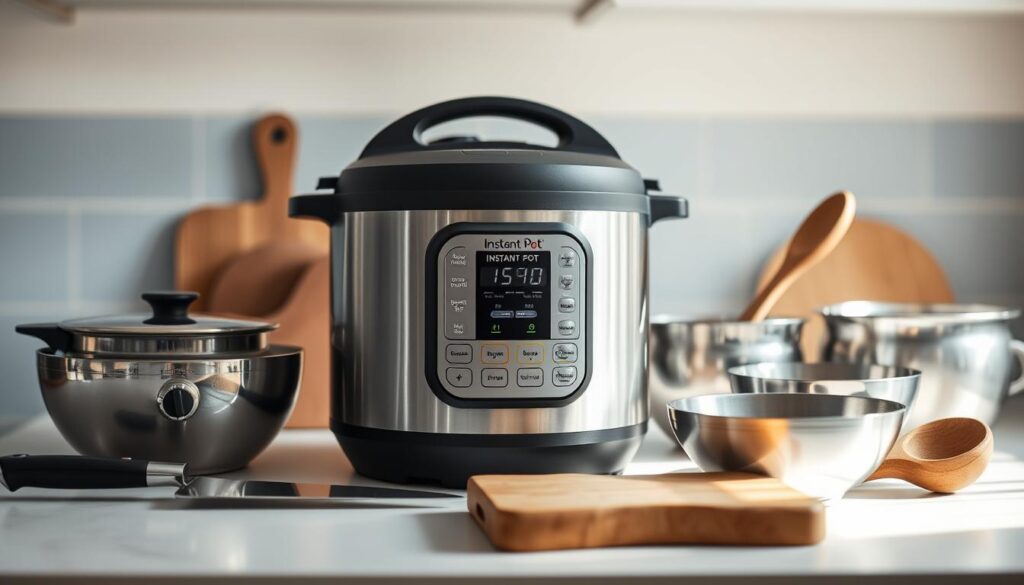
The Instant Pot revolutionized my Sundays. From dried beans to tender roasts, it slashes cooking times by 70%. Compare that to slow cooker methods:
| Tool | Chicken Thighs | Brown Rice |
|---|---|---|
| Instant Pot | 15 minutes | 22 minutes |
| Oven | 45 minutes | 50 minutes |
Three game-changing benefits:
- One-pot meals eliminate stovetop juggling
- Delayed start functions let you prep ingredients ahead
- Consistent results for beginners (no scorched pans)
But don’t overlook other time-savers. Immersion blenders whip sauces directly in pots, saving 10 minutes per cleanup. Mandoline slicers create uniform veggie cuts in seconds—crucial for even roasting.
Safety first: Always check pressure cooker seals before use. Keep vents clear, and never force-open lids. As one reader shared: “Learning the quick-release method changed my weeknight game!”
These tools aren’t just for experts. With preset functions and foolproof timers, anyone can craft restaurant-worthy dishes. Your kitchen arsenal should adapt to your life—whether that’s 15-minute curry nights or hands-off Sunday stews.
Cost-Effective and Budget-Friendly Meal Prep Ideas
My grocery bill shocked me last winter—$200 weekly for a family of four, with half going to waste. That’s when I discovered strategic meal design cuts costs without sacrificing nutrition. Now, I create hearty dishes for under $3 per serving using simple swaps and smart planning.
- Build meals around seasonal produce and sale items
- Use versatile proteins like eggs and canned tuna
- Repurpose leftovers into new dishes (yesterday’s roasted veggies become today’s frittata)
Batch cooking slashes expenses through bulk purchases. A 5-lb bag of frozen chicken breasts costs 40% less per pound than fresh. Cook once, then use it in tacos, soups, and salads all week. Compare these protein options:
| Ingredient | Cost/Serving | Protein |
|---|---|---|
| Lentils | $0.35 | 18g |
| Canned salmon | $1.20 | 22g |
| Greek yogurt | $0.75 | 17g |
Try this easy meal formula: Combine 1 cup cooked rice ($0.25), ½ cup black beans ($0.20), and salsa ($0.30). Top with a fried egg ($0.15) for 22g protein at $0.90 total. Calories? A satisfying 450 per bowl.
Pantry staples become lifesavers during tight weeks. Oats transform into savory porridge with spices and frozen spinach. Canned tomatoes form the base for chili or curry. Remember: True savings start before you shop—plan three meals sharing common ingredients to minimize waste.
Customizing Meal Prep for Different Dietary Needs
A client recently asked me: “How do I feed my vegan sister and carnivore husband without cooking two separate meals?” The answer lies in strategic ingredient overlap. By prepping versatile components, you can build plates that satisfy diverse preferences while keeping your kitchen sane.
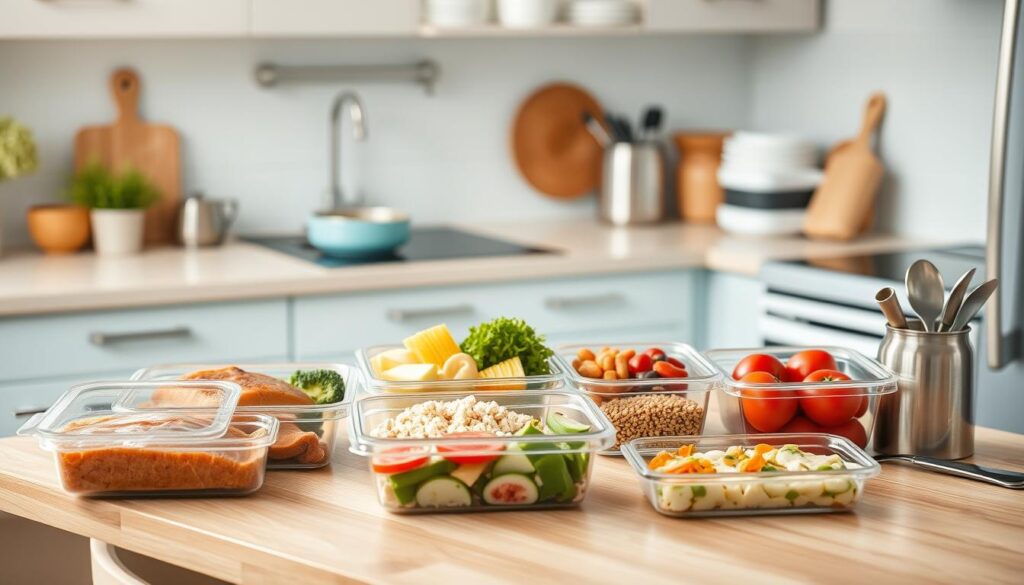
Plant-Powered Foundations
For plant-based eaters, focus on texture-rich staples. Roasted chickpeas add crunch to salads, while marinated tempeh works in wraps or stir-fries. Avocado becomes your multitasker—mash it into dressings, slice it for grain bowls, or blend into chocolate mousse for dessert. One batch of lentil-walnut “meat” crumbles can advance three meals: stuffed peppers, pasta sauce, or lettuce cups.
Animal Protein Flexibility
Chicken thighs shine in meat-centric plans. Grill extras for Cobb salads, shred into tacos, or cube for skewers. Always cook 25% more than needed—leftovers become next-day chicken salad with grapes and almonds. For variety, swap chicken for pork tenderloin or salmon, using similar marinades to save time.
| Diet Type | Prep Strategy | Flavor Boost |
|---|---|---|
| Plant-Based | Batch-cook quinoa + roasted veggies | Tahini-lemon drizzle |
| Meat-Focused | Pre-marinate proteins | Chimichurri sauce |
Feel free to mix approaches. A taco bar with spiced black beans and grilled chicken lets everyone build their ideal plate. For those making diabetic-friendly adjustments, swap tortillas for lettuce wraps and add extra avocado slices. The key? Advance your planning by identifying shared ingredients across dietary needs—like bell peppers or fresh herbs—then prep them in bulk.
Remember: Meal customization isn’t about perfection. Keep dressings and toppings separate until serving. This lets picky eaters omit ingredients while keeping your base components intact. With a little creativity, one cooking session fuels a week of diverse, satisfying meals.
Overcoming Common Meal Prep Challenges
Last winter, I accidentally froze an entire batch of marinara sauce without labeling it—turns out, cinnamon-spiced pasta isn’t a crowd-pleaser. We’ve all faced kitchen facepalms, but these moments teach us smarter strategies. Let’s tackle common hurdles with fixes that keep your plans on track.
Timing troubles top the list. When roasted veggies burn because you’re juggling three tasks, try this: Set staggered oven timers using your phone. One client shared: “Alarms for each baking sheet saved my weekly sweet potato fries.”
| Challenge | Quick Fix | Time Saved |
|---|---|---|
| Soggy salads | Layer dressings separately | 5 min/day |
| Bland flavors | Pre-mix spice blends | 10 min/week |
| Breakfast burnout | Freeze smoothie kits | 8 min/morning |
Ingredient fails happen. That limp spinach? Blend it into pesto for grain bowls. Burnt quinoa? Mix with nut butter for energy bites. As I tell my cooking class students: “Perfection isn’t the goal—adaptability is.”
“Keep backup roasted nuts and hard-boiled eggs on hand. They’re lifesavers when plans change.”
Create a recovery kit: shelf-stable items like canned beans, instant rice, and frozen veggies. These let you assemble meals in minutes when fresh supplies run low. Rotate proteins weekly to avoid taste fatigue—swap chicken for marinated tempeh or shrimp.
With practice, you’ll navigate mishaps like a pro. Start small: Master one new fix each week. Soon, you’ll handle surprises with a laugh and a spatula.
Expert Tips and Insights for Successful Batch Cooking
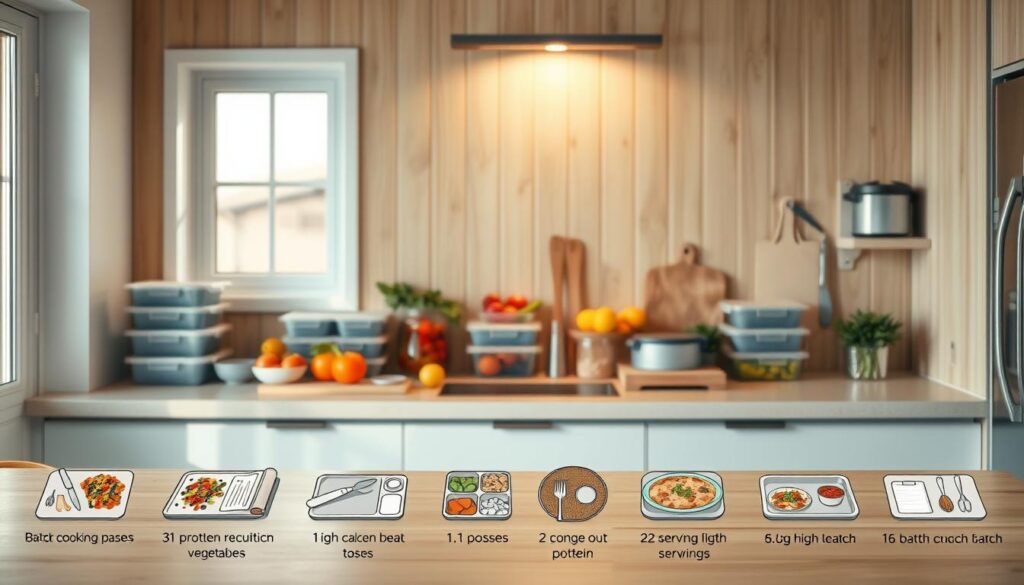
“Batch cooking transformed my clients’ relationship with food,” shares nutritionist Kate Lyman. Professionals like Lyman and meal prep coach Jennifer Blow emphasize smart systems over perfection. Their strategies turn chaotic kitchens into efficient hubs.
Proven Methods for Flavorful Results
Blow’s #1 rule? “Cook once, eat thrice.” Roast double the chicken to use in tacos, salads, and soups. Lyman suggests marinating proteins in reusable containers—this infuses flavor while saving cleanup time.
- Freeze sauces in ice cube trays for portion control
- Layer grain bowls vertically to prevent sogginess
- Label containers with cooking dates using masking tape
Modify standard dishes with texture twists. Swap rice for riced cauliflower in stir-fries, or add toasted pepitas to oatmeal. Small tweaks keep meals exciting without extra effort.
“Batch success starts with forgiving recipes,” notes Blow. “Choose dishes that taste great reheated—stews, roasted veggies, braised meats.”
| Common Mistake | Expert Fix |
|---|---|
| Bland grains | Cook in broth instead of water |
| Soggy veggies | Roast at 425°F for caramelization |
Start with one change weekly—like pre-chopping onions every Sunday. These incremental shifts build habits that stick. Your future self will thank you during hectic Wednesdays.
Developing a Sustainable Meal Prep Routine
What if your kitchen could run like your favorite playlist—smooth transitions and no skipped beats? Sustainability starts with rhythms, not rules. Build a system that bends with your week instead of breaking under pressure.
Start small. Designate one drawer for grab-and-go containers. Keep spices in labeled jars near the stove. These micro-habits create flow. As Chef Callie notes: “Consistency isn’t about perfect Sundays—it’s creating touchpoints that anchor your week.”
| Routine Element | Planned Approach | Unplanned Result |
|---|---|---|
| Prep Days | Wednesday + Sunday sessions | Last-minute store runs |
| Storage | Labeled glass containers | Mystery leftovers |
| Flavor Boosters | Pre-mixed spice blends | Bland repeats |
Adaptability beats rigidity. Got called into work early? Swap roasted veggies for frozen stir-fry mixes. Hosting friends? Use pre-cooked grains as a base for build-your-own bowls. This rhythm makes easy meal prep feel automatic.
Track progress visually. Stick a weekly checklist on your fridge—three checkmarks mean movie night. Celebrate small wins like mastering freezer labels or nailing portion sizes. Momentum builds through these victories.
What makes easy meal prep stick? Alignment with your natural rhythm. Night owls might chop veggies at 9 PM. Early birds can simmer oats while brewing coffee. Match tasks to your energy peaks for effortless consistency.
Imagine waking up to a fridge stocked with ready-to-assemble ingredients—no frantic chopping or 7 AM grocery dashes. That’s the freedom intentional planning creates. By cooking versatile components in advance, you’ll transform hectic afternoons into stress-free mealtimes.
Small actions spark big changes. Start with one batch-cooked grain or protein this week. Use Sunday’s roasted chicken in wraps, salads, or stir-fries. Soon, you’ll notice reclaimed time and energy multiplying like perfectly stacked containers.
Every day offers fresh opportunities to refine your routine. Did today’s lunch assembly feel smoother? Celebrate that win. Struggled with portioning? Adjust tomorrow’s approach. Progress beats perfection every time.
Remember: Consistency builds confidence. Stick with simple systems that fit your rhythm. Whether you prep three days or seven, each effort strengthens your kitchen skills. Keep spices handy, containers labeled, and creativity flowing.
Ready to begin? Grab those sheet pans and start building your culinary toolkit. Your future self—relaxed and nourished—will thank you. After all, great meals shouldn’t require heroic efforts—just smart prep and a dash of courage.
Rainbow Roasted Vegetables
A vibrant medley of seasonal vegetables, roasted to perfection. This dish not only pleases the eyes with its array of colors but also delights the palate with its rich flavors. Perfect as a side dish or a main for vegetarians.
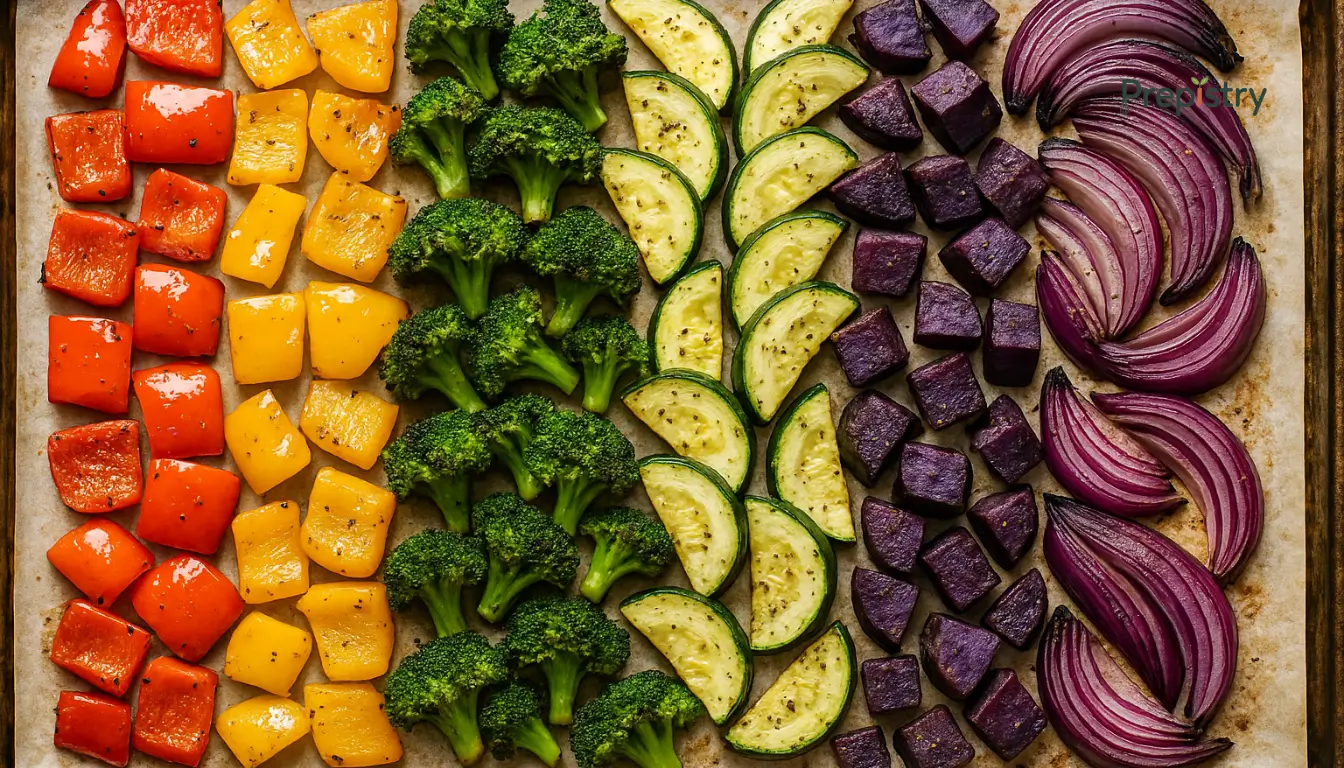
Nutrition Information
Equipment Needed
- Baking sheet
- Mixing bowl
- Chef's knife
- Cutting board
- Oven
Ingredients
-
1 red bell pepper, chopped
-
1 yellow bell pepper, chopped
-
1 zucchini, sliced
-
1 cup broccoli florets
-
1 cup purple cabbage, chopped
-
2 carrots, sliced
-
2 tablespoons olive oil
-
1 teaspoon salt
-
1/2 teaspoon black pepper
-
1 teaspoon dried thyme
Instructions
Recipe Video
Rainbow Roasted Vegetables Recipe
Learn how to make Rainbow Roasted Vegetables, a healthy and colorful side dish that's perfect for any meal. This recipe is easy to follow and brings a burst of flavor and nutrition to your table.

